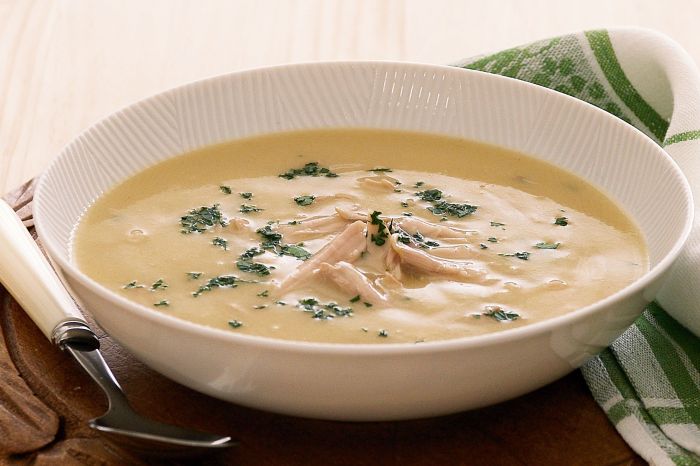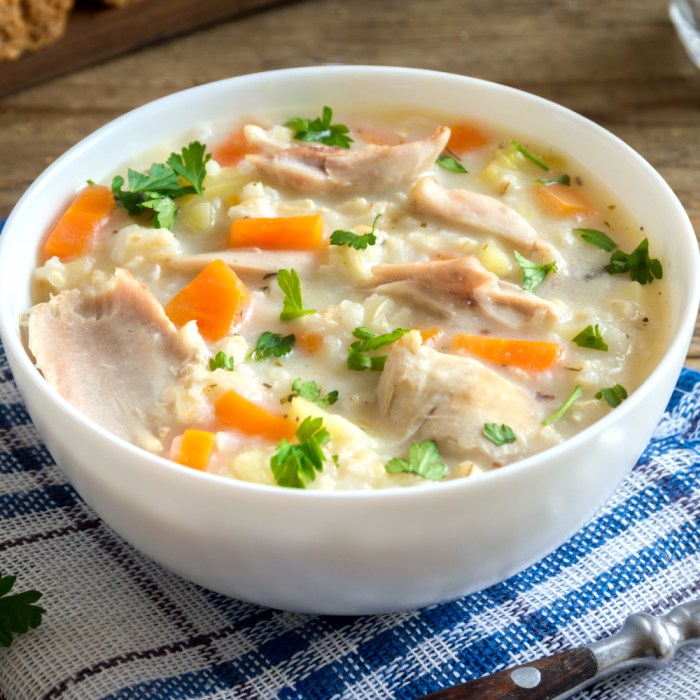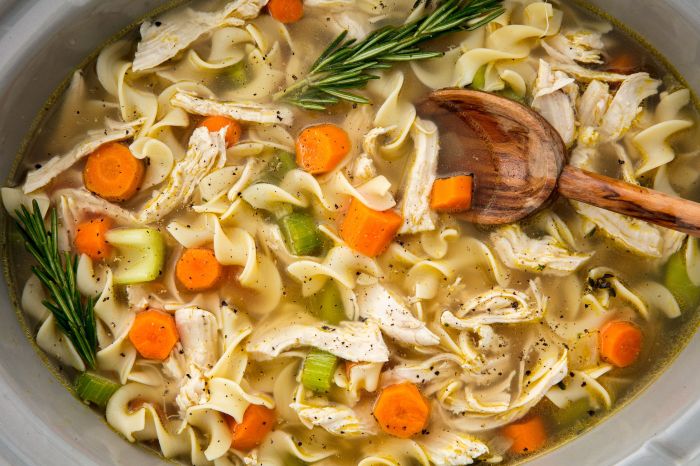Recipe Variations
Chicken cream soup recipes – Chicken cream soup is a classic comfort food, but its versatility allows for endless flavor explorations. The following sections detail several unique variations, highlighting different flavor profiles and thickening techniques. These recipes offer a range of options, from familiar favorites with a twist to exciting new culinary adventures.
Five Unique Chicken Cream Soup Recipes
These recipes showcase the adaptability of chicken cream soup, moving beyond the traditional flavors to embrace diverse culinary influences.
- Creamy Tomato Chicken Soup: This variation combines the richness of cream with the tangy sweetness of tomatoes. Roasted tomatoes add depth, while a touch of balsamic vinegar provides a sophisticated counterpoint to the creamy base. Fresh basil adds a bright, herbaceous note.
- Spicy Chicken & Chipotle Cream Soup: A fiery twist on the classic, this recipe incorporates chipotle peppers in adobo sauce for a smoky, spicy kick. A touch of lime juice brightens the flavors, while a sprinkle of cilantro adds freshness.
- Southwestern Chicken & Corn Cream Soup: This vibrant soup features roasted corn, black beans, and poblano peppers for a Southwestern flair. The creaminess is balanced by the slight spice of the peppers and the sweetness of the corn. A garnish of crumbled cotija cheese adds a salty, tangy finish.
- Curried Chicken Cream Soup: This exotic variation blends the comforting creaminess of chicken soup with the warmth of curry spices. Coconut milk adds richness and a subtle sweetness, while a squeeze of lemon juice balances the flavors. Garnish with chopped cilantro and toasted slivered almonds.
- Mushroom & Chicken Cream Soup: Earthy mushrooms elevate this classic soup. Sautéed cremini and shiitake mushrooms add depth and umami, complementing the creamy texture and savory chicken broth. A touch of thyme adds an aromatic layer of flavor.
Three Variations of Classic Chicken Cream Soup Thickening Agents
The texture of chicken cream soup is crucial to its appeal. The following variations explore different thickening methods, each yielding a slightly different consistency.
- Roux-Thickened Chicken Cream Soup: A classic method, a roux (a mixture of butter and flour) is cooked to create a smooth, creamy base. This method provides a rich, velvety texture and allows for easy control of the soup’s thickness.
- Cornstarch-Thickened Chicken Cream Soup: Cornstarch creates a lighter, less dense consistency compared to a roux. It’s a quick and easy way to thicken the soup without adding a significant amount of flavor.
- Cream Cheese-Thickened Chicken Cream Soup: Cream cheese adds both creaminess and thickness to the soup, resulting in a rich and decadent texture. It also adds a subtle tangy flavor that complements the chicken and broth.
Nutritional Information Comparison
| Recipe | Calories (per serving) | Fat (grams per serving) | Protein (grams per serving) |
|---|---|---|---|
| Creamy Tomato Chicken Soup | 250 | 12 | 20 |
| Spicy Chicken & Chipotle Cream Soup | 280 | 15 | 22 |
| Southwestern Chicken & Corn Cream Soup | 270 | 14 | 18 |
| Curried Chicken Cream Soup | 300 | 18 | 25 |
| Mushroom & Chicken Cream Soup | 260 | 13 | 21 |
Ingredient Exploration
Chicken cream soup, a comforting classic, relies on a harmonious blend of ingredients to achieve its signature creamy texture and savory flavor. Each component plays a crucial role in the overall taste and consistency, and understanding these roles allows for greater control and customization in the recipe.The foundation of chicken cream soup is, naturally, the chicken. The broth provides the base liquid, while vegetables add depth and complexity, and finally, the cream lends its signature richness and velvety texture.
The careful selection and preparation of each ingredient significantly impact the final product.
Chicken Selection and Its Impact
The type of chicken used dramatically alters the soup’s flavor and texture. Bone-in chicken, such as thighs or a whole chicken, yields a richer, more intensely flavored broth due to the marrow and connective tissues rendering during simmering. This results in a deeper, more complex taste profile. Rotisserie chicken offers convenience and a subtly seasoned flavor, contributing a quicker cooking time, but often lacks the depth of flavor found in bone-in options.
Chicken breast, while lean and tender, provides a milder flavor and can sometimes result in a less flavorful broth if not carefully prepared. Using leftover cooked chicken is also a time-saving option, offering convenience without sacrificing too much flavor.
Dairy Choice: Cream, Half-and-Half, or Milk
The choice of dairy significantly impacts the soup’s richness and mouthfeel. Heavy cream, with its high fat content, creates the creamiest, most luxurious texture. It lends a decadent richness and a velvety smoothness that is unparalleled. Half-and-half, with its lower fat content, offers a lighter, less intensely creamy texture. The resulting soup is still creamy, but possesses a slightly thinner consistency compared to heavy cream.
Milk, the lowest in fat content, yields the thinnest and least rich soup. While still palatable, it lacks the decadent texture and richness provided by heavier dairy options. The choice ultimately depends on personal preference and desired level of richness. For a lighter, healthier version, half-and-half or even milk can be suitable substitutes.
The Role of Broth and Vegetables
Chicken broth forms the liquid base of the soup, contributing significantly to its overall flavor. A high-quality broth, homemade or store-bought, will elevate the taste. Vegetables, often including carrots, celery, and onions, add depth of flavor and nutritional value. They contribute sweetness and savory notes, enhancing the overall complexity of the soup. The type and quantity of vegetables used can be easily adjusted to suit individual preferences, adding a personalized touch to the recipe.
For example, adding mushrooms would lend an earthy flavor, while adding peas would add a touch of sweetness.
Cooking Methods & Techniques

Source: com.au
Creating a delicious chicken cream soup hinges on the cooking method employed. Different methods offer varying levels of convenience and impact the final texture and flavor of the soup. Below, we explore three popular approaches: stovetop, slow cooker, and Instant Pot.
Stovetop Chicken Cream Soup
The stovetop method offers precise control over the cooking process, allowing for adjustments along the way. This method yields a soup with a rich, nuanced flavor.
- Sauté diced onions, carrots, and celery in butter or oil until softened. This foundational step builds the soup’s flavor base.
- Add cooked and shredded chicken (about 2 cups) to the vegetables. Pre-cooked chicken ensures faster cooking times and consistent texture.
- Stir in chicken broth (approximately 4 cups), ensuring the chicken and vegetables are fully submerged. Adjust the amount of broth for your desired consistency.
- Bring the mixture to a simmer, then reduce heat and cook for 15-20 minutes, allowing the flavors to meld. This slow simmering extracts maximum flavor from the ingredients.
- Stir in heavy cream (1 cup) or half-and-half, and season with salt, pepper, and other preferred spices (such as thyme, parsley, or paprika). Avoid boiling after adding the cream to prevent curdling.
- Simmer for another 5 minutes, or until heated through. Do not boil. Taste and adjust seasonings as needed.
Slow Cooker Chicken Cream Soup
The slow cooker provides a hands-off approach, perfect for busy schedules. Its gentle cooking produces a remarkably tender chicken and deeply flavorful broth.
- Combine diced onions, carrots, and celery with cooked and shredded chicken in the slow cooker.
- Pour in chicken broth, ensuring all ingredients are submerged.
- Cook on low for 6-8 hours or on high for 3-4 hours, until the vegetables are tender.
- Stir in heavy cream or half-and-half and seasonings during the last 30 minutes of cooking time. The lower temperature of the slow cooker minimizes the risk of curdling.
Instant Pot Chicken Cream Soup
The Instant Pot offers speed and convenience, delivering a creamy soup in a fraction of the time. Pressure cooking tenderizes the chicken and vegetables efficiently.
This recipe uses pre-cooked chicken to reduce cooking time. Adjust seasonings to your taste.
Ingredients: 2 cups cooked and shredded chicken, 1 cup diced onion, 1 cup diced carrots, 1 cup diced celery, 4 cups chicken broth, 1 cup heavy cream, 1 teaspoon dried thyme, salt and pepper to taste.
Instructions:
- Combine all ingredients except heavy cream in the Instant Pot.
- Pressure cook on high for 5 minutes, followed by a natural pressure release for 10 minutes, then a quick release of any remaining pressure.
- Carefully stir in the heavy cream. Avoid high heat to prevent curdling.
- Season with salt and pepper to taste.
Serving Suggestions & Enhancements

Source: licious.in
Elevating a simple bowl of chicken cream soup into a truly memorable culinary experience involves thoughtful consideration of both presentation and flavor enhancement. The right garnish can transform a comforting classic into a visually stunning and deliciously complex dish, while creative serving methods can add a touch of sophistication or playful fun. The following suggestions explore ways to achieve this.
Garnishes significantly impact the visual appeal and taste profile of chicken cream soup. A well-chosen garnish adds texture, color, and a burst of complementary flavor, elevating the overall dining experience.
Five Unique Garnishes for Chicken Cream Soup
The following garnishes offer a variety of textures and flavors to complement the creamy richness of the soup.
Many enjoy the comforting flavors of chicken cream soup recipes, often featuring variations with vegetables or noodles. A similar creamy texture can be achieved in a main course, such as with a chicken casserole with cream of mushroom soup recipe , which offers a hearty and satisfying alternative. Returning to soups, remember that the creamy base in chicken cream soup lends itself well to diverse additions, creating countless possibilities.
- Crispy Fried Sage Leaves: The earthy, slightly peppery flavor of sage contrasts beautifully with the creamy soup, while the crispy texture provides a delightful crunch. Imagine delicate, emerald green leaves scattered across the golden surface of the soup.
- Toasted Pepitas (Pumpkin Seeds): These offer a pleasant nutty flavor and satisfying crunch. Their pale green hue provides a nice visual contrast against the creamy background.
- Chive Blossoms: These delicate purple flowers add a subtle oniony flavor and a touch of elegance. Their vibrant color adds a visual pop to the soup.
- Shredded Rotisserie Chicken: Adding extra shredded chicken provides a boost of protein and a more substantial feel to the soup. The texture contrasts nicely with the creamy base.
- Lemon Zest: A thin ribbon of bright lemon zest adds a citrusy zing that cuts through the richness of the cream, providing a refreshing counterpoint. The vibrant yellow color also adds visual appeal.
Four Ways to Serve Chicken Cream Soup
Serving style significantly impacts the overall dining experience. The following table Artikels four distinct serving approaches, each designed to cater to different occasions and preferences.
| Serving Style | Description | Suitable Occasion | Enhancements |
|---|---|---|---|
| Main Course | Served in a bowl as a hearty and satisfying main course. | Lunch, light dinner | Garnish with shredded chicken, crispy croutons, and fresh herbs. |
| With Crusty Bread | Served alongside a crusty bread roll or baguette for dipping. | Casual dinner, family meal | Use a variety of breads, such as sourdough or rosemary focaccia. |
| As a Dip | Served in a shallow bowl as a dip for vegetables, crackers, or bread. | Appetizer, party snack | Offer a selection of dippers, such as crudités or toasted baguette slices. |
| In a Bread Bowl | Served in a hollowed-out bread bowl for a visually appealing and rustic presentation. | Special occasion, romantic dinner | Use a crusty artisan bread and garnish with fresh herbs and a drizzle of cream. |
Three Creative Uses for Leftover Chicken Cream Soup
Leftover chicken cream soup need not go to waste. Its creamy base and savory chicken flavor lend themselves well to a variety of repurposing opportunities.
- Chicken Pot Pie Filling: Thicken the leftover soup slightly with a roux or cornstarch slurry, then pour it into a pie crust along with some cooked vegetables and top with another crust for a comforting and flavorful pot pie.
- Quiche Filling: The creamy soup can form the base of a delicious quiche. Simply pour it into a pre-made quiche crust, add some cooked vegetables and cheese, and bake until set. The creamy texture and chicken flavor will add depth and richness to the quiche.
- Soup Dumplings (Xiaolongbao): For a truly unique culinary adventure, incorporate the chicken cream soup into the filling of soup dumplings. The rich and savory broth will burst forth upon biting into the delicate dumpling wrapper, creating a delightful and surprising culinary experience.
Dietary Adaptations
Creating delicious and nourishing chicken cream soup shouldn’t exclude those with dietary restrictions. Adapting this classic recipe to accommodate various needs is straightforward, resulting in equally satisfying and flavorful results. The following sections detail modifications for gluten-free, low-sodium, and vegetarian diets.
Gluten-Free Chicken Cream Soup
Making chicken cream soup gluten-free primarily involves ensuring all ingredients are naturally gluten-free or have gluten-free alternatives. This is relatively easy to achieve, as most chicken cream soup ingredients are naturally gluten-free.
- Use Gluten-Free Broth: Many commercially available chicken broths contain gluten as a thickening agent or flavor enhancer. Opt for a certified gluten-free broth to eliminate this risk.
- Check Seasoning Blends: Some pre-made seasoning blends, such as poultry seasoning, might contain gluten. Use a gluten-free blend or create your own from individual spices (such as thyme, rosemary, and sage).
- Confirm Flour-Free Thickening: If you’re using flour to thicken your soup, replace it with a gluten-free alternative such as cornstarch or arrowroot powder. Ensure the thickening agent is thoroughly mixed into a cold slurry before adding it to the hot soup to prevent lumps.
Low-Sodium Chicken Cream Soup
Reducing sodium in chicken cream soup requires careful selection of ingredients and mindful seasoning. Focusing on fresh ingredients and minimizing processed items significantly reduces the overall sodium content.
- Use Low-Sodium Broth: Choose low-sodium or no-salt-added chicken broth as a base. Many brands offer reduced-sodium options.
- Fresh Herbs and Spices: Instead of relying heavily on salt, enhance the flavor profile with an abundance of fresh herbs (parsley, thyme, dill) and spices (black pepper, garlic powder, onion powder). These provide depth of flavor without the added sodium.
- Reduce Salt Gradually: Start by reducing the salt by half compared to your usual recipe. Taste as you go, adding a pinch more only if absolutely necessary. Your palate will adjust to the lower sodium content over time.
Vegetarian Chicken Cream Soup, Chicken cream soup recipes
Transforming chicken cream soup into a vegetarian delight requires a protein substitute that provides a similar creamy texture and satisfying mouthfeel. Mushrooms and lentils are excellent choices.
- Mushroom-Based Soup: Sauté a mixture of cremini, shiitake, and oyster mushrooms until softened and slightly browned. These mushrooms offer a savory, umami flavor that complements the creaminess of the soup. The mushrooms can be pureed partially or completely for a smoother consistency.
- Lentil-Based Soup: Cook red or brown lentils until tender. The lentils add a hearty texture and subtle earthiness. Partially or fully puréeing the lentils after cooking creates a creamy base similar to the chicken version. Adding a touch of vegetable broth can help achieve the desired consistency.
- Vegetable Broth as Base: Replace chicken broth with a rich vegetable broth to maintain the soup’s overall flavor profile. Consider adding a tablespoon of nutritional yeast for a cheesy, umami flavor that mimics the richness often associated with chicken-based soups.
Visual Representation: Chicken Cream Soup Recipes
The visual appeal of chicken cream soup is crucial to its overall enjoyment. A perfectly presented bowl transcends mere sustenance; it becomes an experience. The ideal color, texture, and consistency, combined with thoughtful garnishing and presentation, elevate this classic comfort food to a visually stunning dish.The ideal chicken cream soup boasts a creamy, pale ivory or light golden hue, reflecting the richness of the cream and the subtle color of the chicken.
This should be consistent throughout, without any significant separation of liquids or solids. The texture should be smooth and velvety, with just the right amount of body – thick enough to coat the spoon, yet not so thick as to be gluey. Small, tender pieces of chicken should be evenly distributed throughout, adding visual interest and textural contrast to the smooth cream base.
The overall consistency should be uniform, free from lumps or overly thick areas.
Ideal Visual Presentation
A classic soup bowl, perhaps a rustic stoneware or a sleek white ceramic, provides the perfect canvas for showcasing chicken cream soup. The soup should fill the bowl generously, about ¾ full, leaving enough space to avoid spillage. The lighting should be warm and inviting, perhaps natural light filtering through a window or soft, ambient lighting from a nearby lamp.
The setting could be simple yet elegant – a crisp white tablecloth, perhaps a few sprigs of fresh herbs subtly placed on the table. A crusty, artisan-style bread roll or a slice of toasted baguette, served on a small side plate, complements the soup perfectly. The bread provides a textural counterpoint and offers a vessel for soaking up the delicious broth.
Enhancing Visual Appeal
The visual appeal of chicken cream soup can be dramatically enhanced through strategic garnishing and serving techniques. A simple sprinkle of fresh chopped chives or parsley adds a pop of vibrant green, contrasting beautifully against the creamy base. A few delicate croutons, lightly browned and golden, introduce an appealing textural element and further enhance the visual complexity. A swirl of cream or a dollop of crème fraîche adds a touch of elegance and richness.
For a more sophisticated presentation, consider a garnish of finely shredded cooked chicken breast arranged artfully on top of the soup. Alternatively, a thin slice of lemon, adding a subtle brightness and contrasting color, can be placed on the edge of the bowl. Careful plating, ensuring the soup is smoothly poured into the bowl, contributes significantly to the overall visual impression.
A strategically placed sprig of fresh thyme, both aromatic and visually pleasing, can add a finishing touch. The overall effect should be a harmonious blend of colors, textures, and aromas that tantalize the senses before the first spoonful.
Question Bank
Can I freeze chicken cream soup?
Yes, chicken cream soup freezes well. Allow it to cool completely before storing in airtight containers for up to 3 months.
What can I substitute for chicken broth?
Vegetable broth or even water can be used as a substitute, but the flavor will be altered. Consider adding a bouillon cube for extra flavor.
How can I make the soup thicker?
If your soup is too thin, simmer it uncovered for a while to reduce the liquid. Alternatively, you can whisk in a cornstarch slurry (1 tablespoon cornstarch mixed with 2 tablespoons cold water) or a roux (equal parts butter and flour cooked together).
How long will leftover chicken cream soup last in the refrigerator?
Leftover chicken cream soup should be stored in an airtight container in the refrigerator and consumed within 3-4 days.


